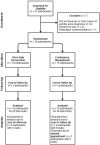Doxycycline prophylaxis to reduce incident syphilis among HIV-infected men who have sex with men who continue to engage in high-risk sex: a randomized, controlled pilot study
- PMID: 25585069
- PMCID: PMC4295649
- DOI: 10.1097/OLQ.0000000000000216
Doxycycline prophylaxis to reduce incident syphilis among HIV-infected men who have sex with men who continue to engage in high-risk sex: a randomized, controlled pilot study
Abstract
Background: Incident syphilis infections continue to be especially prevalent among a core group of HIV-infected men who have sex with men (MSM). Because of synergy between syphilis and HIV infections, innovative means for controlling incident syphilis infections are needed.
Methods: Thirty MSM who had syphilis twice or more since their HIV diagnosis were randomized to receive either daily doxycycline prophylaxis or contingency management (CM) with incentive payments for remaining free of sexually transmitted diseases (STDs). Participants were tested for the bacterial STDs gonorrhea (Neisseria gonorrhoeae), chlamydia (Chlamydia trachomatis) and syphilis at weeks 12, 24, 36, and 48 and completed a behavioral risk questionnaire during each visit to assess number of partners, condom use, and drug use since the last visit. Generalized linear mixed models were used to analyze differences between arms in STD incidence and risk behaviors at follow-up.
Results: Doxycycline arm participants were significantly less likely to test positive for any selected bacterial STD during 48 weeks of follow-up (odds ratio, 0.27; confidence interval, 0.09-0.83) compared with CM arm participants (P = 0.02).There were no significant self-reported risk behavior differences between the doxycycline and CM arms at follow-up.
Conclusions: Daily doxycycline taken prophylactically was associated with a decreased incidence of N. gonorrhoeae, C. trachomatis, or syphilis incident infections among a core group of HIV-infected MSM at high risk for these infections. Safe and effective biomedical tools should be included in the efforts to control transmission of syphilis, especially in this population. A randomized clinical trial should be conducted to confirm and extend these findings.
Conflict of interest statement
References
-
- Centers for Disease Control and Prevention. [Accessed September 1, 2013];2011 Sexually transmitted diseases surveillance - syphilis [CDC Web site] 2013 Jan 15; Available at: http://www.cdc.gov/STD/Syphilis2011/default.htm.
-
- Centers for Disease Control and Prevention. [Accessed February 1, 2014];2012 Sexually transmitted diseases surveillance - syphilis [CDC Web site] 2014 Jan 10; Available at: http://www.cdc.gov/STD/Syphilis2012/default.htm.
-
- Bolan RK, Rudy ET, Cheng KJ, et al. Sexually transmitted infections among HIV positive persons before and after entry into HIV care: the need for priority interventions; Presented at: National HIV Prevention Conference; Atlanta. 2009.
-
- Yorke JA, Nold A, Hethcote HW. Dynamics and control of the transmission of gonorrhea. Sex Transm Dis. 1978;5:51–6. - PubMed
-
- Hall HI, Holtgrave DR, Maulsby C. HIV Transmission rates from persons living with HIV who are aware and unaware of their infection. AIDS. 2012;26:893–6. - PubMed
Publication types
MeSH terms
Substances
Grants and funding
LinkOut - more resources
Full Text Sources
Medical
Research Materials


